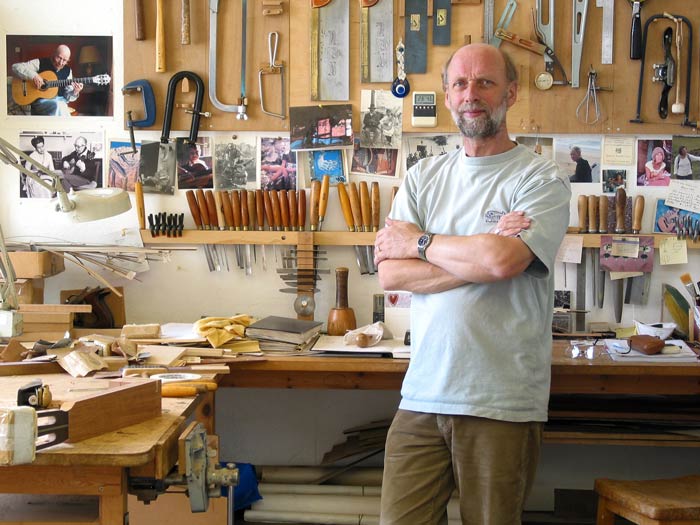Construction
My guitars are constructed in a controlled, dry atmosphere using only the finest and carefully selected seasoned tonewoods. I use only European spruce for the soundboards and Indian or old Brazilian rosewood for the backs and ribs. I can also offer bee’s wing satinwood, bird’s eye maple and cypress as an alternative to the rosewoods.
I make the necks from either South American mahogany or cedar (Cedrela) and the heads are joined using either the Hauser ‘V’ joint or a spliced joint in the case of Torres copies. The heads are faced with ebony or rosewood and the centre joint is often inlaid with strips of decorative veneers to match the rosette.
The wood I use for struts and bars is quarter sawn, and cut from split billets. Struts are glued to the soundboard with fish glue using a solera (dished work board) only when the ambient relative humidity is around 40%. This ensures that the correct doming of the soundboard is achieved in the finished instrument. The top linings are made from separate spruce blocks and the back linings are either kerfed or solid.
I adjust my ebony fingerboards so that the bass side tapers down slightly towards the soundhole. This allows for a constant height of the strings above the soundboard at the saddle and improves the guitars’ playability. I cut my fret slots on a custom made slitting saw using CNC produced templates. The fret positions are therefore consistently accurate and intonation is as perfect as practically possible.
I offer the 12 hole system for tying strings to the bridge. The obvious improvement is that a constant break angle is maintained over the saddle maximising energy transference to the soundboard.
I make all my inlays by hand and individually, which allows me to vary them from one guitar to another, though there are decorative themes running throughout all my guitars such as the fine wheat sheaf herringbone reminiscent of Torres. These days almost all of my inlays are made from natural coloured veneers with the occasional addition of ‘old green’ which is a particular favourite of mine.
Having experimented with numerous finishes over the years, I am satisfied that French polish of shellac is unquestionably the most beautiful sounding and looking finish for a fine classical guitar. Whilst not the most durable finish it is relatively easy to repair and maintain. I fill the pores of the wood with pumice and apply the finish in the traditional way using only freshly mixed pale shellac polish.
“To say that Simon’s instruments are second to none is an understatement. Simon has raised the standard of excellence for guitar making to a level that is unmatched today. His refined craftsmanship and attention to detail are so compelling in themselves as to rise to the level of art.”
Pablo Cohen


Tailored to you…
I tailor my guitars’ fingerboard widths, neck dimensions and string spacing to individual requirements and other options such as a 20th fret and side position dots are also available.
I fit David Rodgers or Klaus Scheller tuning machines which are both available in a variety of styles and materials.
The guitar case which I supply as standard is a Hiscox Pro2 but other cases such as Visesnut or Bam can be supplied as requested.
